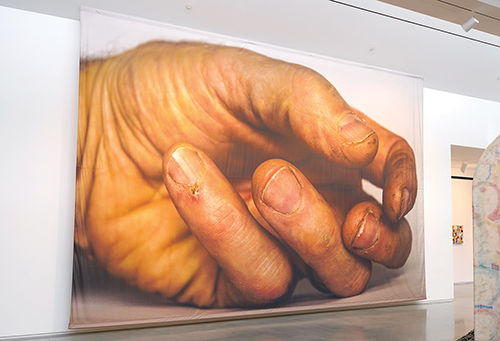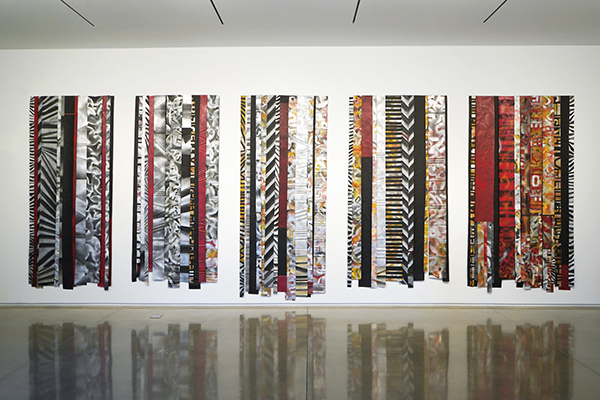CMCA Biennial 2020
Center for Maine Contemporary Art • Rockland, ME • cmcanow.org • Through May 2, 2021
Considering the constraints imposed by COVID-19, the 22nd edition of the Center for Maine Contemporary Art’s Biennial is a masterful feat of curation. From more than 500 submissions, valiant jurors Nina Johnson-Milewski, founder and director of the Nina Johnson Gallery in Miami, and Kate McNamara, visiting critic at RISD and creative director of My HomeCourt in Providence, chose a smorgasbord of artists, 34 in all, representing 17 Maine communities (and a few second homes in New Hampshire, New York, and beyond).

The broad white expanses of the CMCA galleries are put to excellent use via several extraordinary wall works. Phil Lonergan’s 16 x 24′ printed fabric Artist’s Hand, which took a team to produce, is both outsized and intimate. Taking in the spectacle of the workman’s enormous fingers half closed around a creased palm, the viewer also studies the cuts, dirt, and broken nails. The image is resonant with almost Christ-like connotations.

Susan Webster’s wall hanging I Hear Something Coming consists of five panels made from felt paper, paint, thread, and rivets. Like great prayer robes, the shimmering cascades of pattern and color, measuring around 9 x 25′, create a kind of visual respite from challenging times. By contrast, the twisted rope and shards of mirror in Susan Beallor-Snyder’s Broken (Resolution) speak to struggle.
Some works cast an aesthetic glance backwards. Aaron Rosenblum’s Audio Flag (2020), a stack of six CRT monitors with video players, is a “reinterpretation” of Nam June Paik’s 1996 Video Flag from the Smithsonian Hirschhorn Museum. A video of the reflection of Paik’s piece in the surface of the Hirschhorn’s waxed floor is accompanied by audio recordings, including the call and response of protesters in Louisville, KY, this past May and June responding to the murders of Breonna Taylor and David McAtee. Their angry chants reverberate across the room.
The paintings in the show range from the allegorical—Jeffery Ackerman’s dream-like tableaux featuring centaurs and a crowned anarchist—to geometric-abstract—Meg Hahn’s “window gates”—to the neo-pop: Fanny Brodar’s Garden in the Middle of a City, an acrylic and oil pastel that features Elmo seated among child-like drawings. Elsewhere in the show, Jimmy Viera might be channeling modernist Stuart Davis in his acrylic-on-panel Secret Passage with its patchwork of abstract elements.
Speaking of patchwork, Isabelle Maschal O’Donnell offers three pieces made from muslin, canvas, velour, upholstery fabric, faux fur, linen, velvet, and other materials. Recalling the collages of Anne Ryan, the pieces have a crazy-quilt-like quality. Susan Smith’s Mourning Cloth is an arrangement of textile pieces collected at the U.S. border with Mexico, sewn together “in defiance of what has been torn apart.” Rubbed with earth from the area and water from the Rio Grande, the cloth bears photo transfers of scenes of migrants and fencing.

Some of the sculptures in the show highlight the impulse to explore non-traditional materials as a means to critique modern culture. Nick Sevigney’s pedestal piece Dystopian Water Purifier (2018) made from clay and assorted materials, resembles a handwrought bong, yet the title points to a less humorous interpretation: some future desperate attempt to purify water using the remnants of a failed civilization. Sam Finkelstein’s city/walk, Richard Van Buren’s Diver, Benjamin Spalding’s Winged Victory, and Elijah Ober’s “mirror images” have a similar improvised appearance, each evoking the darker side of the zeitgeist.
There’s a lot more to praise and ponder in this show, including notable photography by Hector Nevarez Magaña, Penn Chan, and Mandy Lamb; environmental art by Erin Woodbrey, Gregory Jamie, and Anne Buckwalter; and a few pandemic-related pieces, among them, Donna Festa’s SEEING SIDEWAYS, a group of quick sketches: “Many people made sourdough bread. I bit my fingernails and obsessively made drawings of home.” The show is a testament to the richly diverse and engaging art that makes Maine a hub of the new and the brave.
—Carl Little
